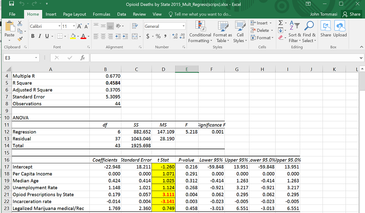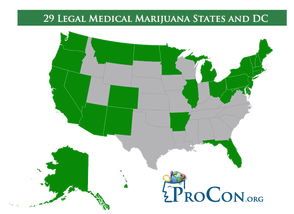
In my study, I looked at opioid deaths by state as the dependent variable and looked at 6 independent variables which were: per capita income by state, median age, unemployment rate, opioid prescriptions /100,000 population, incarceration rate/100,000 and a dummy variable for states that have legalized medical marijuana. After performing a multivariate regression (chart), there was significance and strong evidence that the number of legal opioid prescriptions and incarceration rate play a significant part. Simply put, the greater the number of opioid pain prescriptions will in turn lead to more opioid use. This doesn’t require a large leap of intelligence since your major opioid scrips are for Vicodin, Percocet and OxyContin. All of these are highly addictive and once the prescription expires, it is easier, and cheaper, to substitute heroin purchased on the street, which in turn leads to a downward spiral. What dealers are doing is cutting the heroin with cheaper and more potent (50 times) fentanyl, which in turn has been leading to more deaths from overdoses.

Another variable that showed some correlation, but did not reach significance, was the unemployment rate. If someone is out of work, particularly long term unemployed (more than 26 weeks), depression and lethargy can set in which can lead to increased drug use.
What is very relevant, is that there was no relationship between medical marijuana use and increased opioid use. In a previous study I performed, there was some indication, but no statistical significance, that medical marijuana use could lead to decreased opioid use and deaths. This can be illustrated by a recent study by Dr David Bradford of the University of Georgia, formerly of UNH (http://news.uga.edu/releases/article/medical-marijuana-lowers-prescription-drug-use-0716/ ). For his study he used the statistics that are widely available from Medicare, and he found that in those states that legalized medical marijuana, there was less money spent on Medicare prescription drug use.
“The savings, due to lower prescription drug use, were estimated to be $165.2 million in 2013, a year when 17 states and the District of Columbia had implemented medical marijuana laws. The results suggest that if all states had implemented medical marijuana the overall savings to Medicare would have been around $468 million.
Compared to Medicare Part D's 2013 budget of $103 billion, those savings would have been 0.5 percent. But it's enough of a difference to show that, in states where it's legal, some people are turning to the drug as an alternative to prescription medications for ailments that range from pain to sleep disorders. "The results suggest people are really using marijuana as medicine and not just using it for recreational purposes," said the study's lead author Ashley Bradford, who completed her bachelor's degree in sociology in May and will start her master's degree in public administration at UGA this fall.
To obtain the results, they combed through data on all prescriptions filled by Medicare Part D enrollees from 2010 to 2013, a total of over 87 million physician-drug-year observations.” ( news.ugs.edu ).
What appears to be happening in these state are that Doctors are recommending medical marijuana in lieu of opiates and it is not only saving Medicare part D money, but is in no way a gateway drug.
 RSS Feed
RSS Feed
